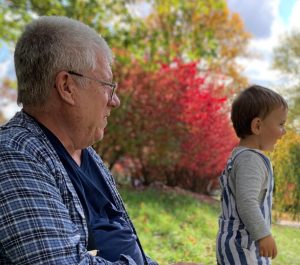
Mar 23 2022 Creative Art with Your Grandchild: Embrace the Temporary
Ages:
3-8Is your refrigerator door filled with your grandchildren’s photos and homemade art pieces? Looking for a way to do creative — yet impermanent — art with your grandchild?

Art, even visual art, need not happen on paper. It is the process of creating art — not the product we create — that activates our brains and expands our imagination. The benefits of creating art happen in the planning, the gathering, the forming, and, especially, in the appreciating — all of which can be done without leaving a permanent mark.
Creating temporary art can happen anywhere and anytime. Capture a quick moment: step back to notice the beauty of your sculpture made out of blocks or frame a pink-and-purple sunset in your mind’s eye. This helps elevate everyday experiences to moments of artistic expression and appreciation. Temporary art can also be an extended process of creative expression, using found objects, recycled materials, or natural elements arranged in meaningful ways.
Here are four media and techniques for creating temporary art with your grandchild.
Sculpture
Use the building blocks, magnetic tiles, or even empty boxes in your home to create sculptural works of art. Talk with your grandchild about the four stages of sculpture: planning, building, admiring, and deconstructing.

The planning phase is a good time to experiment with your equipment. Talk about balance and see how different shapes can stack on top of one another. When you’re ready to build, let your grandchild take the lead; you can build alongside them and model what to do when things don’t work as you planned.
Admiring your work is the step that transforms this activity into art. Step back from your sculpture and notice its form, its balance, its beauty. Does the sculpture look different from different angles? What if you get down low or up high to view it? Notice the shadows that your sculpture casts. Then, when you are ready, knock it down! (Be prepared: your grandchild may want to keep the sculpture out on the table or floor for a few days. Sometimes these works of art are hard to relinquish!)
Papercutting
Recycled paper grocery bags or colored paper or catalogs in your recycling bin work great as an introduction to the art of papercutting. You and your grandchild can cut shapes (circles, triangles, and squares work well) and arrange them in different patterns to create a picture.
An easy shape to cut out is a heart — and with this you can explore the Jewish value of ahavah, love. Perhaps turn your heart into:
- a flower and think of ways that love grows.
- a butterfly and think of ways love changes.
- a house and think of ways that you can make your home a place of love.
Even with a few simple shapes, the creative possibilities are endless.
Found-Object Collage
 Have you and your grandchild ever spent time looking through an “I Spy” book or magazine with hidden images? A hidden-pictures scene is easy to create in your home with regular household items. Choose one color and collect toys, books, clothes, or other items and arrange them on a table or rug. You can tailor your collage to fit an upcoming holiday or family milestone; for example, add in a dreidel, Kiddush cup, Hanukkah candle, or Hebrew letter magnets.
Have you and your grandchild ever spent time looking through an “I Spy” book or magazine with hidden images? A hidden-pictures scene is easy to create in your home with regular household items. Choose one color and collect toys, books, clothes, or other items and arrange them on a table or rug. You can tailor your collage to fit an upcoming holiday or family milestone; for example, add in a dreidel, Kiddush cup, Hanukkah candle, or Hebrew letter magnets.
If you are using objects from nature, make sure to use only items that are already on the ground. Fallen leaves, rocks, and sticks are great; your neighbor’s roses should be left where they are (but are perfect for Nature Vignettes below!). Once you’ve filled up your space, your grandchild can take a photo and send it to a parent, sibling, or friend with the challenge of what to find.
Nature Vignettes
On your next nature walk, use your hands to highlight the beauty that surrounds you. When you see something that catches your eye, create a picture frame with your fingers by touching your thumbs and index fingers together. Ask your grandchild to look at the picture. What do they notice?

Or gather natural objects that intrigue your grandchild, for example, different kinds of pinecones and acorns, shells or rocks, or twigs and sticks. Together, create a display and let your child name it, perhaps even creating a small sign such as “Cara’s Cone Collection” or “Jonah’s Amazing Twigs.” Invite other family members to view the vignette before removing the sign and dispersing the natural objects.
Appreciating the natural world is woven into the Jewish story from its beginnings as recounted in the Torah — one of our first roles as humans is to care for the earth (to “till and tend it” in some older translations). We are shomrei adamah, guardians of the earth, with the responsibility of keeping our planet beautiful, so that future generations can continue to appreciate its splendor.
Rabbi Emily Meyer is the creator of Doodly Jew, a project designed to spark creativity in Hebrew learning. She believes in the power of art to create meaningful engagement with Jewish tradition. She lives in Pittsburgh, PA with her husband, Rabbi Aaron Meyer, their two children and a pet poodle.




 We use technologies like cookies to remember your preferences. Consenting to these technologies will provide you with a better browsing experience. JGN never shares information about your use of our website.
We use technologies like cookies to remember your preferences. Consenting to these technologies will provide you with a better browsing experience. JGN never shares information about your use of our website.